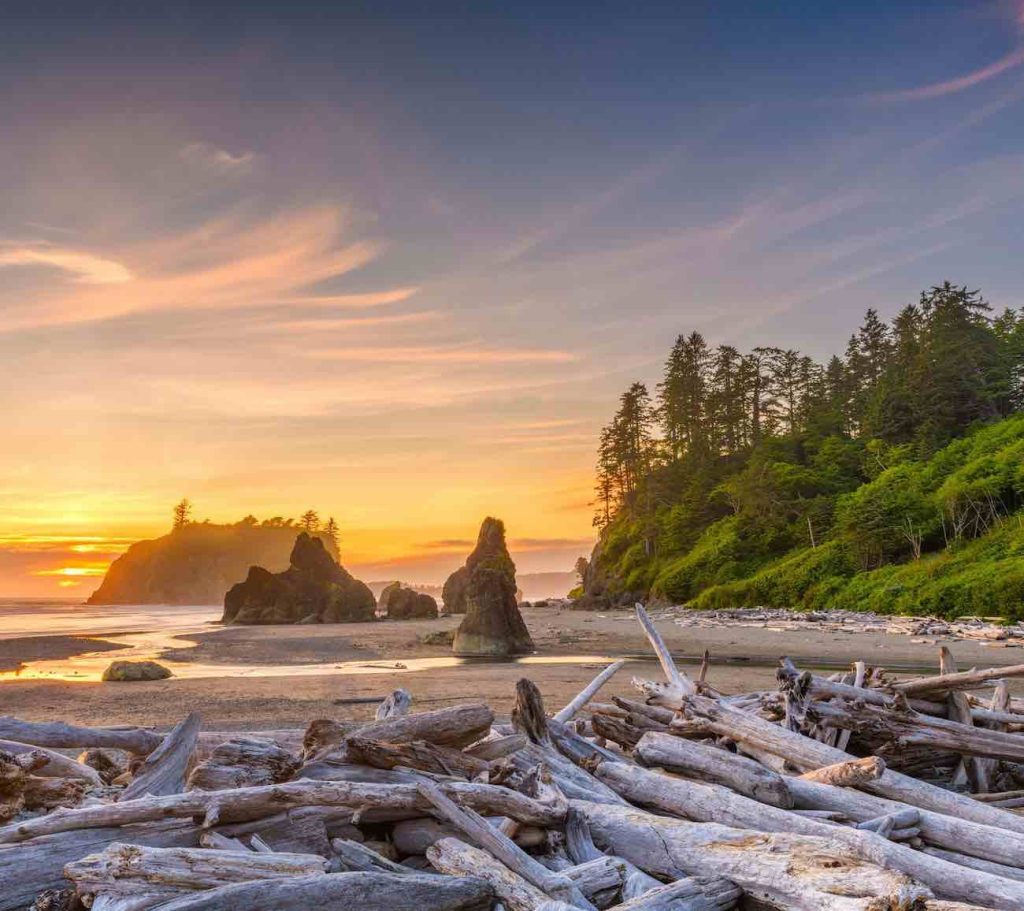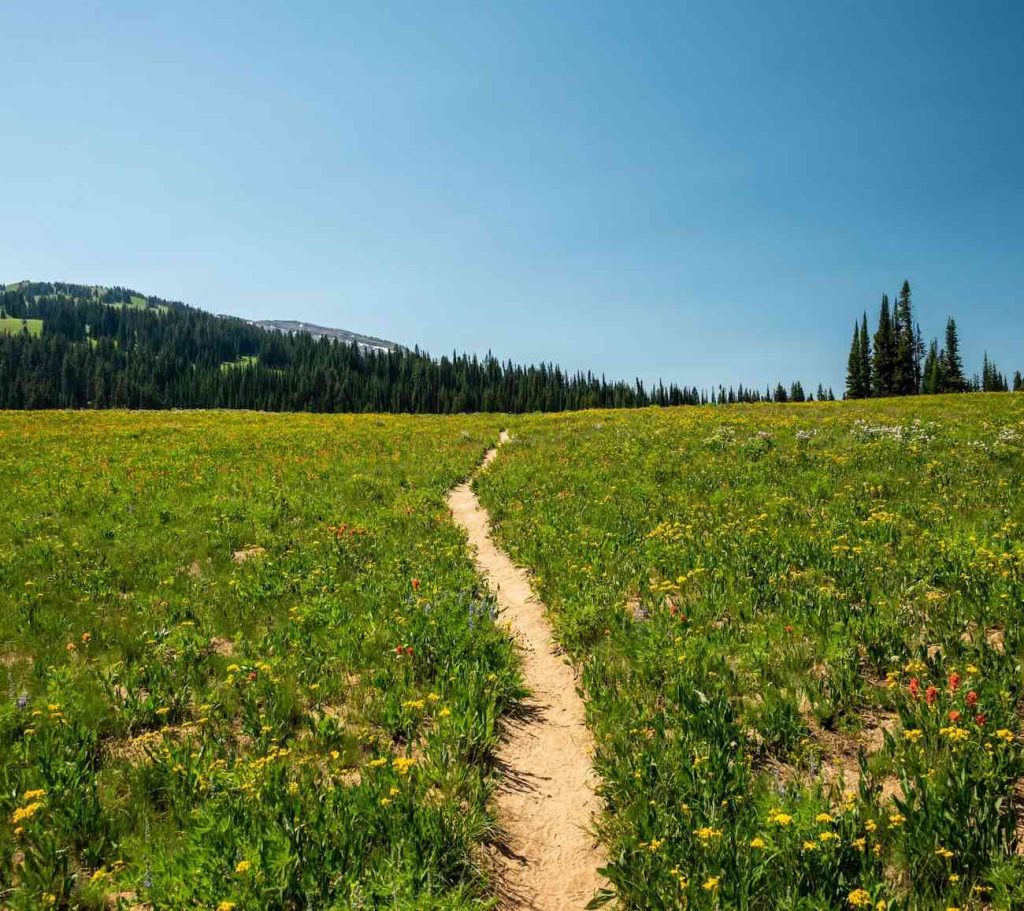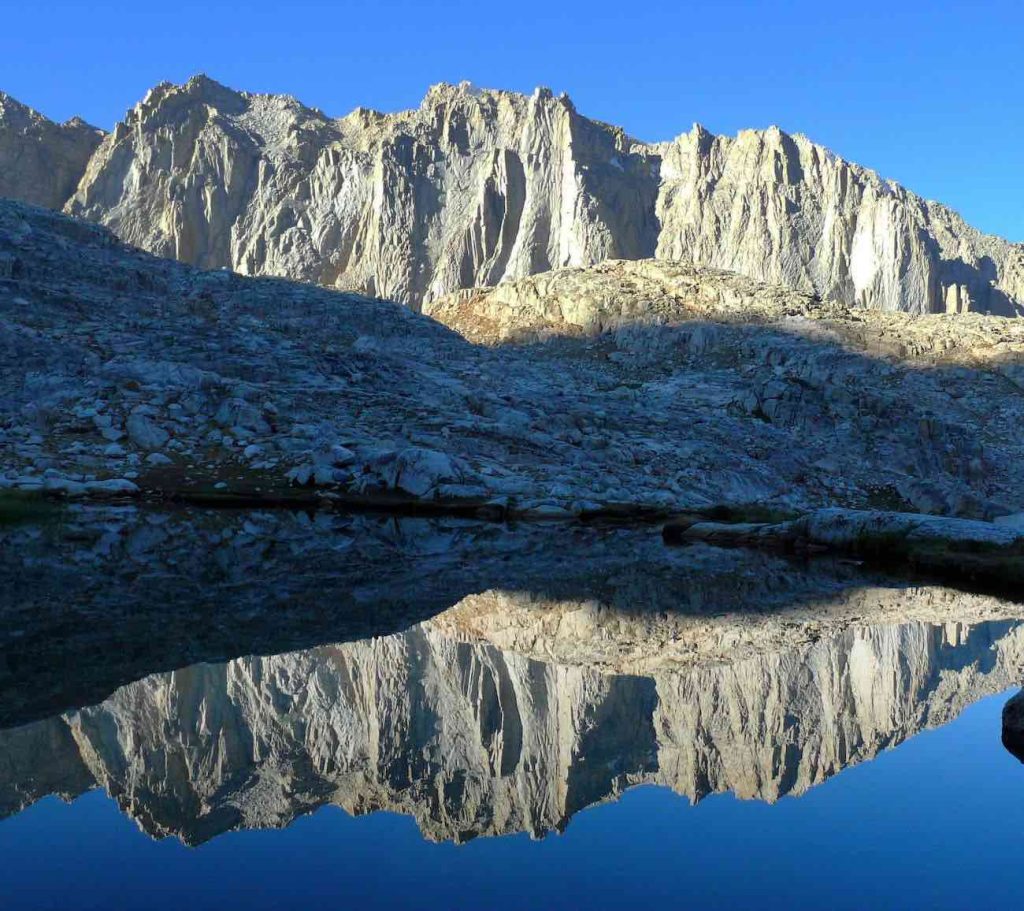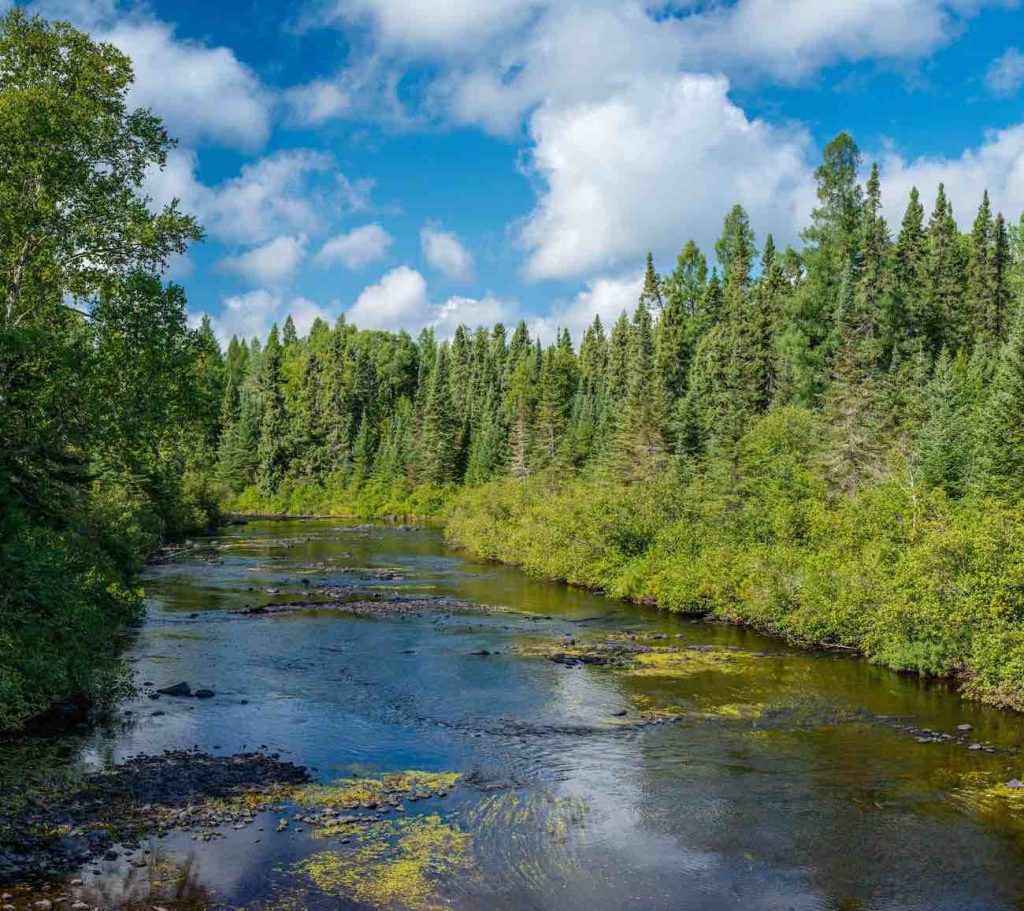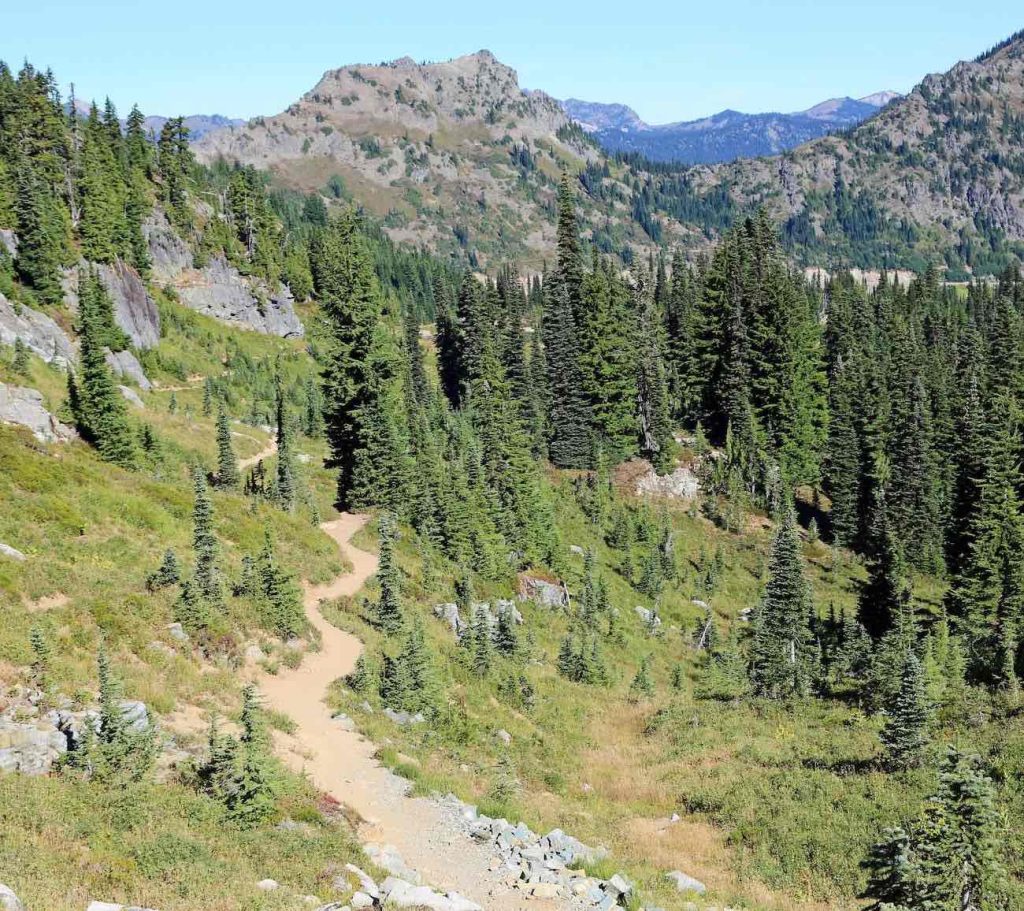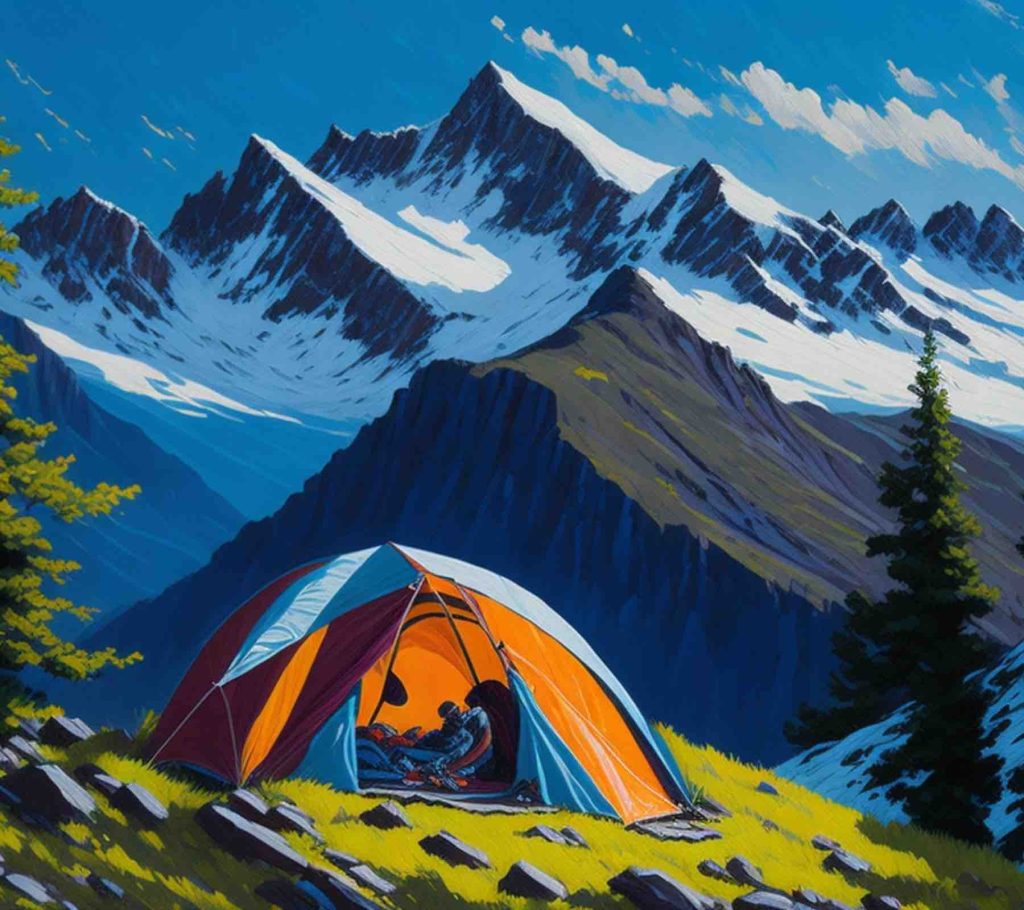
If you’re an outdoor lover looking for adventure, the United States offers some of the most iconic backpacking hikes in the world.
From tough trails like Mount Rainier’s Wonderland Trailhead to beginner-friendly options like Yosemite Falls, this article provides a list of must-see backpacking trails to discover the best trails the United States has to offer.
Key Takeaways
- The US offers a variety of unforgettable trails, with vistas that include waterfalls and alpine forests.
- Different trails provide varying levels of difficulty; beginners may prefer trails like Yosemite Falls while the more experienced may be up for routes like the Teton Crest or Alum Cave to Mount LeConte trail.
- A backpacking adventure gives you the chance to experience breathtaking views, explore unique ecosystems and disconnect from everyday life – all while testing your personal limits!
- It is important to be aware of permit requirements and weather conditions before taking on any hiking and camping trips in the US.
Top Backpacking Trails In The US
The United States offers a variety of options to discover the wilderness in protected national parks and forests.
Best Beginner Backpacking Trails
Skyline Trail Loop, Mount Rainier National Park
- Length: 5.5 miles (8.8 km)
The Skyline Trail Loop in Mount Rainier National Park is a popular and stunning trail that winds up the slopes of one of America’s most iconic volcanoes.
With 5.5 miles and 1,700 feet of elevation gain, this strenuous hike will take your breath away with its beautiful sights. The views along the way include lush pine forests, the magnificent Myrtle Falls, and glacier-carved valleys and peaks.
The main trail takes about 4-5 hours. However, you should also plan on stopping at landmarks like Frozen Lake or Panhandle Gap, to relax, take photos and enjoy nature’s beauty.
South Kaibab Trail (with Bright Angel Trail) Grand Canyon National Park
- Length: 6.8 miles (11 km) one way
- Noteworthy campsites: Phantom Ranch
The South Kaibab Trail is one of the most breathtaking hikes in Grand Canyon National Park, Arizona. The trailhead starts at the North Rim and extending to the Grand Canyon’s South Rim, this roughly 7-mile (one way) route descends more than 6,000 feet into an awe-inspiring chasm of ancient rock.
The trail winds down through towering hoodoos, narrow ridge lines, and stunning outcroppings, including Ooh Aah Point and Cedar Ridge Viewpoint.
This hiking trail is steep with a high elevation, so it’s important to be physically prepared. You can combine this hike with the Bright Angel Trail via Phantom Ranch for an even more exciting and challenging experience.
Upper Yosemite Falls Trail, Yosemite National Park
- Length: 7.2 miles (11.6 km) round trip
- Noteworthy campsites: None mentioned in the search results
The Upper Yosemite Falls Trail in Yosemite National Park is one of the most famous backpacking trips in the U.S. that takes you to the top of North America’s tallest waterfall to enjoy views of Half Dome and the valley below. With 3,000 feet of elevation gain, this day trip is considered a challenging summit. It’s been an engineering marvel since 1870, when construction first began.
Alum Cave Trail To Mount LeConte, Great Smoky Mountains National Park
- Length: 11 miles (17.7 km) round trip
- Noteworthy campsites: LeConte Lodge
The Alum Cave Trail to Mount LeConte in the Great Smoky Mountains National Park has long been considered as one of the best hikes in America.
With natural geological formations, and an old-growth forest, landmarks along this route includes Inspiration Point (1,700 ft.), Arch Rock (2,220 ft.), and Alum Cave Bluff (4,800 ft.) You will reach the summit at a height of 6,593 feet, with 360-degree views of the surrounding area.
Cottonwood Lakes Trail, Sierra Nevada California
- Length: 11.6 miles (round trip)
The Cottonwood Lakes Trail is a great choice for novice backpackers looking to start with a manageable trail that can be completed in 1 day. This 11-mile loop is rated as one of the most user-friendly paths in the Sierra Nevada mountains.
The North Coast Route, Olympic National Park
- Length: 20 miles (32 km)
- Noteworthy campsites: Toleak Point, Third Beach
Presidential Traverse, New Hampshire
- Length: 23.9 miles (38.5 km)
- Noteworthy Campsites along the trail: No noteworthy campsites mentioned in the search results
The Presidential Traverse in the White Mountains of New Hampshire covers 19-23 miles that includes eight mountain peaks of rugged terrain that make up part of the White Mountain National Forest with an average elevation of about 8,000 feet from start to finish.
Weather conditions can shift on a daily basis in this area, so make sure to bring layers of clothing and weather resistant gear. This hike spans multiple days, so proper trip planning is key.
Pawnee and Buchanan Pass Loop, Colorado
- Length: 27 miles (43.5 km)
Situated in the Indian Peaks Wilderness of Colorado, the Pawnee and Buchanan Pass Loop is a 27-mile expedition that is considered one of the best backpacking trips in Colorado.
The trail goes over two mountain passes: Pawnee Pass (12,542 feet) and Buchanan Pass (11,837 feet). The journey includes subalpine forests, colorful foliage in open pastures, and mountain scenery. This hike is made up of several parts, each of which can be completed in a day or two.
During your journey, you’ll come across Monarch Lake and several lookout points like Isolation Peak. There are also camping options on the trail on grassy knolls and granite slabs, like the Bear Lake camping area, which is perfect for stargazing at night.
Best Intermediate Backpacking Trails
Teton Crest Trail
- Length: 40 miles (64 km)
- Noteworthy Campsites along the trail: Death Canyon Shelf, South Fork
The Teton Crest in the Wyoming Grand Teton National Park is a 40-mile journey that follows a dramatic southward path through landscapes of peaks and meadows. It takes hikers from an elevation of 6,600 feet to a maximum of 10,700 feet. Experienced hikers will enjoy this classic backpacking trip, but even first-timers can handle the Teton Crest due to its relatively easy terrain. Just make sure to pack plenty of warm clothes because it it’s usually chilly at night and early morning.
Skyline Trail Loop, Pacific Northwest
- Length: 44.6 miles (71.8 km)
- Noteworthy Campsites along the trail: Marmot Meadows, Snowbowl
If you’re looking for a Pacific Northwest adventure, don’t miss the trail in Mount Rainier National Park. This 22-mile loop has views of glaciers and old-growth forests as it climbs around 5,800 vertical feet. Although the stats may seem intimidating, with large elevation gains and losses throughout its circuitous path, it’s still recommended for beginner / intermediate backpackers who want to experience a multi-day backcountry trip.
The Wonderland Trail, Mount Rainier National Park
- Length: 93 miles (150 km)
- Noteworthy campsites: Indian Bar, Mystic Lake
The Wonderland is a continuous circuit encompassing 93 miles around Mount Rainier, with spectacular views from its alpine ridge trail. It covers diverse ecosystems that provide views of wildflowers, icy glaciers, old-growth forests, and mountain lakes.
Best Advanced Backpacking Trails
John Muir Trail (JMT), Sierra Nevada California
- Length: 211 miles (340 km)
- Noteworthy Campsites along the trail: Tuolumne Meadows, Red’s Meadow, and Muir Trail Ranch
The John Muir Trail is a 211-mile trail in the Sierra Nevada mountains of California, from Yosemite National Park to Mt. Whitney and passes through Kings Canyon and Sequoia National Parks.
It is considered one of the most beautiful trails in America, because of its majestic 14,000-foot peaks, peaceful forests, verdant grassy knolls, and sparkling alpine lakes. It’s also located in what some people consider to be America’s best national park, Yosemite. Thru-hiking this trail is an unforgettable challenge, especially because of extreme weather conditions that can occur at higher altitudes during the summer months. It may take 3 weeks to 1 month or longer to complete, depending on your pace.
Superior Hiking Trail
- Length: 310 miles (498 km)
- Noteworthy Campsites along the trail: Split Rock River Loop, Gooseberry Falls State Park, and Silver Bay
The Superior Hiking Trail is a 310-mile long trail located in the US state of Minnesota. It crosses Lake Superior and includes 7 state parks and the Superior National Forest.
Considered one of the best trails in the United States, the trailhead starts amidst rocky ridges and vibrant forest scapes culminating through lush valleys that lead up to high peaks ranging from 1,300 to 1724 ft! When hiking this trail visitors can enjoy beautiful views over rolling hills or along pristine lakeside landscapes.
Furthermore, it offers unparalleled experiences for different skill levels with overnight camping sites along its course as well as day hikes up mountain tops boasting stunning architecture created by nature itself.
Colorado Trail
- Length: 486 miles (782 km)
- Noteworthy Campsites along the trail: Copper Mountain, Twin Lakes, and Durango
The Colorado Trail is a notable path for its length and beauty, spanning 486 miles (782 km), with gorgeous panoramic views of the Rockies, diverse terrain, pristine forests, alpine lakes, and rugged peaks.
This route stretches from Denver to Durango in southwestern Colorado, connecting the mountain towns of Leadville, Copper Mountain Resort, Frisco, the Breckenridge ski resort area, and Vail Pass Summit along its winding route.
Planning this hike takes time, and every person should consider their physical fitness level before tackling the lengthy journey that passes through six national forests. But those who decide to embark on this unique journey won’t be disappointed by this epic adventure.
Pacific Crest Trail (PCT)
- Length: 2,650 miles (4,265 km)
- Noteworthy Campsites along the trail: Lake Morena, Warner Springs, and Big Bear Lake
The Pacific Crest Trail (PCT) is one of the best trails in the US, encompasses diverse scenery from California up to Canada. At over 4,200 kilometers long it is considered a premier long-distance trail with some of the most spectacular landscapes in North America.
The PCT officially begins at the Mexico border and culminates in snowy mountains of British Columbia and covers deserts, forests, alpine lakes, volcanoes and everything in between along its route.
Appalachian Trail (AT)
- Length: 2,193 miles (3,529 km)
- Noteworthy campsites: Blood Mountain Shelter, Watauga Lake Shelter
The Appalachian Trail is one of America’s premier long-distance trails. At 2,200 miles (3,540 km), the AT stretches from Georgia to Maine and passes through 14 states, running along the ridge lines of the Appalachian Mountains.
Hiking the Appalachian Trail will bring different challenges depending on where you are, such as rocky paths in North Carolina or mosquitoes in Massachusetts. This trail can take anywhere from five to seven months, with many people walking about 30 miles per day on average.
Remember to make sure to bring good socks so your feet won’t get wet when you cross rivers with high water, and don’t forget to enjoy beautiful sunsets once you reach milestones like Roan Mountain, which is the highest point on the whole trail at 6,293 feet.
Continental Divide Trail (CDT)
- Length: 3,100 miles (4,989 km)
- Noteworthy Campsites along the trail: Ghost Ranch, Pie Town, and Grants
The Continental Divide Trail (CDT) is a 3,100-mile network of small roads and hiking routes traversing five U.S states in the Rocky Mountains from Montana to New Mexico along the Continental Divide.
The Continental Divide Trail (CDT) offers an incredible backcountry experience for wilderness adventurers. With 25 National Forests, 21 Wilderness Areas, and 3 National Parks along its route, the CDT provides majestic beauty at every turn. In Colorado alone, hikers have access to 740 miles of this trail, offering spectacular views and breathtaking sights up mountain slopes.
The Continental Divide Trail is considered one of the most difficult American trails, alongside the Pacific Crest and the Appalachian. This is because of its undulating terrain, rapidly changing elevation levels, and remote location far from civilization. As a result, there are very few opportunities for restocking food or medical supplies.
Backpacking Considerations
When planning your trip, it’s important for beginners to consider several factors.
- Safety: Look into potential dangers, such as hazardous mountain passes or remote locations with limited access to help in case of an emergency. Additionally, it is important to research the availability of amenities like bathrooms, water sources and campsites along your path in advance for comfort and convenience when on the trails.
- Meals & Water: While packing essential gear is necessary for any journey, it’s also prudent to pack extra food and water – at least 2-3 thousand calories and 1 gallon of water per day – since most people burn around 3 thousand calories each day while hiking.
- Research: Make sure to sufficiently prepare fore your chosen route by researching terrain difficulty, details about amenities available along the way as well as packing enough food/gear accordingly beforehand; capabilities either through own research or via guidance from experts ensuring safe and memorable hikes every time!
Guided Trips And Their Benefits
Guided backpacking trips provide a great way for both experienced and novice hikers to explore the outdoors with added security and support.
Guided backpacking trips provide an ideal opportunity for adventure and exploration while allowing you to experience maximum solitude in remote locations. With the expertise and knowledge of a professional guide, your safety and enjoyment are maximized. Here are some of the main advantages of taking part in a guided trekking or wilderness trip:
- Expertise & Knowledge: Professional guides can provide valuable tips on advanced techniques, navigation skills, local customs, wildlife viewing opportunities and other aspects that will help make your trip more enjoyable.
- Gear Support & Group Dynamics: Guided treks often come with gear support included – every hiker is typically issued their own tent, boot liners, cooking equipment or food rations which makes it easier to enjoy the scenery without having to worry about carrying heavy items around all day long.
- Physical Fitness & Safety Benefits: Hiking has been proven to have numerous health benefits ranging from physical exercise to emotional or mental relief – something that can be even more rewarding if experienced during a long-distance one-on-one journey with nature under the guidance of someone who knows your capabilities well enough in order insure your safety at all times.
Recommendations for Guided Backpacking Trips
The following table showcases various providers and the types of guided trips they offer:
| Provider | Types of Services Offered |
|---|---|
| Four Season Guides | Long-distance thru-hiking, mountain high routes, off-trail travel, and custom trips |
| Country Walkers | Guided walking and hiking tours, including inn-to-inn trips and off-the-beaten-path adventures |
| Glacier Guides | Backpacking trips in Glacier National Park, Montana, as well as multi-day rafting trips and custom adventures |
| Wildland Trekking | Guided backpacking trips in popular national parks, including Grand Canyon, Yosemite, and Zion, as well as international destinations |
| REI Adventures | Multi-day backpacking trips across the United States and international destinations, with options for beginners and experienced backpackers |
Tips For Choosing The Right Backpacking Trail
When selecting the right backpacking trail, understanding your physical fitness level and the difficulty of the route is key for an enjoyable experience.
Evaluate Your Physical Fitness And Skill Level
It is important to honestly assess your physical fitness and skill level in order to choose the right trail for a safe and enjoyable adventure. Start by consulting with a doctor or trainer who can help you identify existing health issues or discuss any concerns you may have about tackling an extended trip.
- Knowing your exact capability will not only ensure your safety, but it will also save time so you don’t end up choosing a route that is too difficult for you.
- You want to make sure you are physically fit enough before setting off on longer routes, which require technical climbing skills such as rock scrambling and crossing high bridges.
- To practice for this type of hiking, try going on smaller hikes that still challenge you while building confidence in yourself and strengthening necessary muscles groups like legs, lower back, core, arms etc .
- After gaining more experience with different levels of terrain difficulty (particularly ascents), take additional research into account by considering the elevation gain/loss throughout each trail.
- Every hike varies greatly based on location — depending if it’s through mountains or deserts–so understand what climate zone these trails are located in prior to attempting them.
Consider Trail Difficulty And Length
Choosing the right route is an important part of having a successful outdoor adventure. Evaluating both the difficulty and length of a trail is essential to find a route that can be successfully navigated, allowing hikers to enjoy their trip without putting themselves in danger.
Difficulty should take into account elevation gain, terrains such as flat or steep ground, environmental conditions like mud or snow-covered trails, hazardous areas like rivers or cliffs, and any other potential risks along the way.
The length must also be considered so that you have enough time during your trip for side adventures and rest days. All these factors play into selecting an appropriate trail for each individual’s skillset and physical abilities to ensure safe navigation and enjoyable experience on the journey ahead.
Before committing to a particular hike it’s important to research thoroughly in order to understand how difficult it will be based on personal fitness considerations – taking age, weight etc into account – as well as looking at terrain type , climate information regarding weather forecasts throughout different times of year, possible obstacles en route such as river crossings which may need special skillsets beyond basic navigating capabilities etc .
Research Weather And Trail Conditions
The weather and trail conditions can have a significant impact on any trip. It is vital to research them before heading out for the adventure. Unexpectedly high temperatures or sudden rainstorms, as well as difficult terrains incorporating steep angled climbs, dense foliage or marshy areas, can make an arduous trek of four days feel like two weeks! To prepare properly for a backpacking journey it pays to find out everything there is to know about the current weather patterns in the region and on-ground difficulties that may be encountered.
One way of gathering this information is through National Park websites which provide details on isolated campsites as well as advice about fluctuating temperature changes seasonally within specific parks if they apply.
Being aware of these educated warnings from reputable sources reduces potential risks during your hike significantly. Additionally checking with local rangers regarding current condition updates are essential since they’re likely knowledgeable about one-off events such as forest fires along popular routes or dangerous wildlife seeking refuge from changing environmental factors which could further impact hikers safety when taken by surprise.
For example an early thaw period leading towards springtime may introduce new slippery sections over glaciers or watershed caused routes which aren’t visible at first glance but put hikers in harm’s way if unprepared and caught up unaware due to lack of planning beforehand.
Plan For Permits And Campsites
Planning for permits and selecting the right campsite is essential before embarking on a trip. Many of America’s best trails require some type of permit, such as wilderness use permits, national park entrance passes, or special camping permits. These can be acquired online ahead of time without any hassle, often at reduced prices.
When choosing a campsite, research availability based on location and season. Certain sites may have restrictions due to wildlife protection or other regulations from local parks departments. Fees for BLM campgrounds are also required to help maintain facilities and usually involve limitations when selecting a spot.
Backpackers may camp without a permit in most areas of the forest if staying no more than one night in any specific location. However, it’s vital to leave your site cleaner than when you arrived by using portable stoves instead of charcoal briquettes whenever possible, and practicing proper Leave No Trace principles, such as packing out all of your trash including food waste debris.
In addition, certain parks and trails, such as Grayson Highlands State Park and Mt. Whitney, have their own unique regulations. Make sure to research and understand these ahead of time if you plan on visiting such places.
Multi-Day Hikes And Their Unmatched Beauty
Multi-day hikes offer an unparalleled chance for exploration of some stunning landscapes in the US, from coastlines to mountain ranges and everything in between.
A Look At Long-Distance Trails
Long-distance trails offer experiences that go beyond what you can get on day hikes. You can fully immerse yourself in nature and explore landscapes from coast to coast or even across entire countries.
Some popular long-distance trails in the US are:
- The Appalachian Trail (AT): It’s nearly 2,200 miles long and runs through 14 states, from Georgia to Maine.
- The Pacific Crest Trail (PCT): It’s more than 2,650 miles long, starting from the Mexican border in California and ending in Washington state. It takes at least five months to complete and you’ll cross multiple wilderness areas and areas with endangered species.
- The Continental Divide Trail (CDT): It’s 3,100 miles long and connects three American national parks – Rocky Mountain NP, Yellowstone NP, and Glacier NP. You’ll see awe-inspiring scenery, especially when exploring Colorado’s Valley floor.
- The John Muir Trail (JMT): It’s 222 miles long and goes through eight mountain passes in the Sierra Nevada region. You’ll be surrounded by breathtaking scenery.
Before embarking on a multi-day hike, make sure you’re physically prepared and have the proper equipment. Wear appropriate footwear and clothing and know how to navigate and identify hazardous conditions. Always prioritize safety!
Four Pass Loop, Colorado
- The Four Pass Loop in Colorado is a strenuous 26-mile journey through the Maroon Bells-Snowmass Wilderness that draws hiking enthusiasts from around the world.
- The iconic loop passes four high alpine passes, each more than 12,000 feet above sea level; and take you through stunningly beautiful landscapes which range from wildflower fields to peaceful lakesides.
- Notable landmarks include breathtaking Snowmass Lake and other soaring peaks such as Pyramid Peak and Maroon Peak. It’s a challenging trail but one that many outdoor lovers deem worthy of their time because of its almost unparalleled beauty.
Lakeshore-North Country Trail, Michigan
The Lakeshore-North Country Trail in Michigan is the ultimate outdoor experience for backpackers and hikers alike.
For those looking to camp along their way or opt for lazy days along sandy beaches can access amenities like designated swim areas, disc golf facilities modern bathroom facilities that have been made available by the state’s department of natural resources which not only help make your trip memorable but are safely secured & maintained too.
With such varied terrain & careful maintenance; Lakeshore North Trails could be great option for novice trekkers who simply want to enjoy nature with appropriate guidance & support from professionals.
John Muir Trail, California
- The John Muir Trail is a world-renown long-distance hiking trail that passes through Yosemite, Kings Canyon, and Sequoia National Parks in the Sierra Nevada mountain range of California.
- The trail is 210 miles long and crosses high elevations as it traverses along the crest of this magnificent mountain range. It boasts some of the most awe-inspiring scenery in the US, including waterfalls, glaciers, alpine lakes, and meadows full of wildflowers.
- Popular with both experienced backpackers and hikers wanting to do shorter section hikes (ranging from 28 miles to 65 miles), backcountry permits are required for overnight stays in several areas along the trail, while no reservations are necessary during the summer season.
- Hikers should be prepared for changing weather conditions at higher altitudes with appropriate gear before taking on this challenging but rewarding journey.
Appalachian Trail, Maine
- The Appalachian Trail in Maine offers hikers a rugged journey of unpredictable terrain and a lifetime worth of memories. This section of the trail extends over 213 miles across the state, with elevations that range from sea level to 5268 feet at Mount Katahdin.
- Along this route, hikers will be delighted by fantastic scrambling up and down rocky ledges on mountain ridge lines as well as sections of wooded forests, open meadows and pristine lakes found in the interior regions.
- Notable landmarks along the way include Saddleback Mountain with its characteristic cliffs providing sweeping views over the lush green valleys below, enchanting waterfronts such as Nahmakanta Lake where one can hear loon calls echoing into eternity and Bigalow Mountain boasting some amazing sunsets for those fortunate enough to witness them.
Essential Gear For Backpacking Trips
- Backpack and Sleeping Bag
- Tent
- Navigation Tools
- Water Filter and Purification Tablets
- First Aid Kit
Regardless of the destination, all backpackers should make sure that they bring essential gear for a backpacking trip such as a comfortable backpack, sleeping bag, sturdy tent, navigation tools (maps/GPS), water filter or purification tablets, and a well stocked first aid kit.
Backpack And Sleeping Bag
Backpacking in the great outdoors requires the right gear, and one of the most important items is a high-quality backpack and sleeping bag. The backpack should be large enough for your equipment and supplies but comfortable and lightweight enough that you can carry it comfortably over miles of terrain.
High-end backpacks with adjustable shoulder straps make sure it fits snugly against your back to provide optimal support without straining muscles or joints.
A good sleeping bag is equally essential; they come in many different insulation types (down fill or synthetic) as well as various kinds of shapes to fit your body’s shape perfectly while keeping you warm at night regardless if temperatures drop low during cold weather months.
You also need a bag that’s light in weight so you don’t have any extra baggage on multi-day hikes but still prevents drafts — often called “draft collars”— around the neck region where heat escapes quickly from poor construction designs.
Tent
Choosing a tent for backpacking is critical if you want to have a comfortable and successful trip. A lightweight, compact tent will help with transportation of gear, while durable materials and features like a waterproof rainfly are key factors for protection from the elements.
Ideally, it should be easy to set up as well — no one wants to spend 30 minutes just getting ready before they start exploring! When selecting your tent, think about the size and number of people who’ll be using it: backpacking tents typically come in 1-person or 2-3 person sizes.
You’ll also need to consider weight (the lighter the better!) and ventilation; some folks opt for high-tech mesh tarp panels that provide plenty of airflow on hot days but still protect against mosquitos and other pests.
Navigation is fundamental while backpacking, with the selection of proper tools and knowledge as to how to use them necessary for a successful trip. The most important navigational tools are the map, compass, altimeter watch, GPS device and personal locator beacon (PLB).
Maps provide an overview of geographic features such as topography with greater detail than what’s available with online apps. A compass is generally used in conjunction with a map when navigating through unknown terrain so you don’t get lost or disoriented.
Altimeters help you accurately measure your elevation since traditional maps only provide contour lines. In order to always have a point of reference, GPS devices are invaluable pieces of outdoor gear used by professionals; they’re also great if it gets dark or Murphy’s Law kicks in! Lastly PLBs can be life saving if you find yourself far from civilization or in need of rescue on harsh terrains such as mountainsides.
Water Filter And Purification Tablets
Backpacking trips require special gear to ensure a safe and enjoyable experience, and one of the most important items for any trek is a reliable water filter or purification system.
It’s essential to have access to clean drinking water when you’re in the backcountry, as untreated water can contain parasites, bacteria, viruses, and other organisms that may make you sick.
One solution often used by backpackers are compact pumps such as the Sawyer Squeeze which offers an ultralight option suitable for filtering large quantities of water quickly.
There are also bottle-style portable units like LifeStraw which can be taken on day hikes where pumping isn’t viable due to weight restrictions. For larger groups there are gravity filters like Katadyn BeFree Water Filtration System which allows several people to share filtered streamwater without having to wait around while each individual filters their own drinks from a jug.
First Aid Kit
Bringing a backpacking first aid kit on hikes and adventures is essential, as it can help treat minor injuries or illnesses that may occur while out in the wilderness.
A good backpacking first aid kit should contain essential items such as bandages, painkillers, antiseptic wipes, insect repellent, sunscreen, and tweezers. The Adventure Medical Ultralight Kit is a popular choice for backpackers due to its ideal mix of weight (only 8 ounces), size (4”x6”), and contents.
This helpful little medical pouch goes beyond traditional outdoor medical supplies like band-aids and medications. It includes
- sting relief pads
- duct tape which can double as severe wound closure
- bear spray
- ivy wash solution for treating poison ivy rash before it spreads
- mole skin patches for blisters
- tincture of benzoin adhesive sealant for protecting cuts from dirt particles and gritty sand
- electrolyte tablets for replenishing lost salts during physical activity
Conclusion: Choose Your Adventure On The Best Backpacking Trails In America.
Backpacking is an incredible way to explore the vast and diverse landscapes of America. From coast to coast, there are exceptional trails for all skill levels – from beginner hikes for those just starting out, to multi-day expeditions through some of the most awe-inspiring locations in the world.
The physical and mental benefits of backpacking are undeniable; choosing your own outdoor adventure helps you disconnect from every day life and reconnect with nature while taking in incredible views.
FAQs:
1. What are the best backpacking trails in the US?
Some of the top backpacking trails in the United States include The Appalachian Trail, John Muir Trail, Pacific Crest Trail, and Tahoe Rim Trail. Each of these trails offer a unique and challenging experience for hikers of all levels.
2. How can I prepare for an extended hike on one of these trails?
In order to properly prepare for an extended hike on one of these trails, you should make sure that you have taken training courses or consulted with experienced trail guides to help ensure your knowledge and skillset matches up with what is required to traverse such terrain effectively, while still staying safe along the way. Additionally – proper packing & gear selection based upon anticipated weather and environment can also go a long way towards successful completing.
3. Are permits necessary when traveling through any national parks included within US backpacking routes?
Yes – obtaining permit beforehand is typically mandatory before entering into certain regions, due environmental rules & regulations.
Related Posts:






